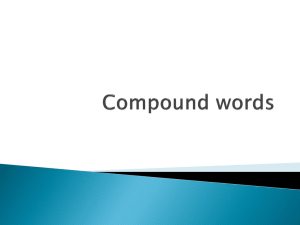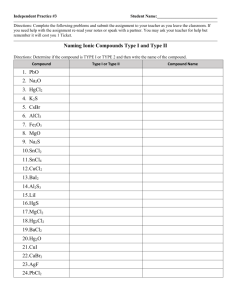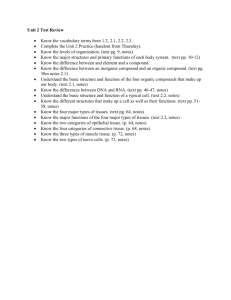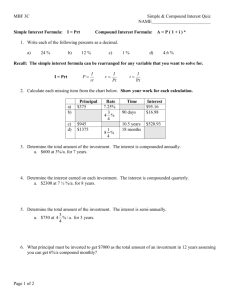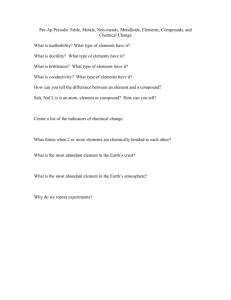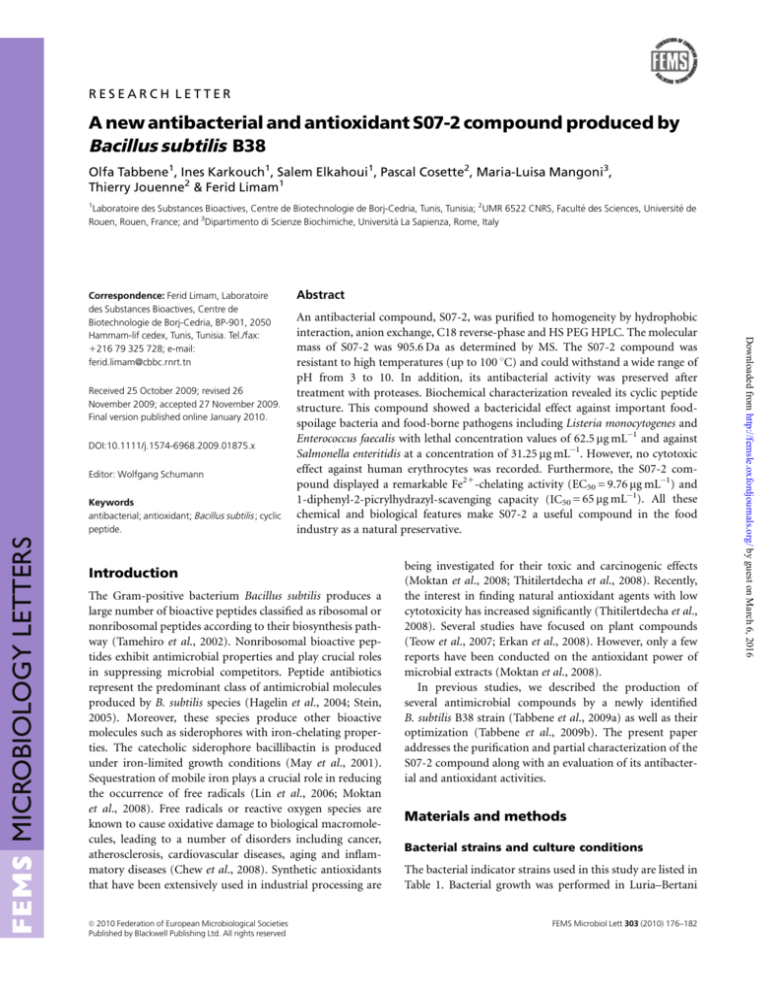
RESEARCH LETTER
A new antibacterial and antioxidant S07-2 compound produced by
Bacillus subtilis B38
Olfa Tabbene1, Ines Karkouch1, Salem Elkahoui1, Pascal Cosette2, Maria-Luisa Mangoni3,
Thierry Jouenne2 & Ferid Limam1
1
Laboratoire des Substances Bioactives, Centre de Biotechnologie de Borj-Cedria, Tunis, Tunisia; 2UMR 6522 CNRS, Faculté des Sciences, Université de
Rouen, Rouen, France; and 3Dipartimento di Scienze Biochimiche, Università La Sapienza, Rome, Italy
Received 25 October 2009; revised 26
November 2009; accepted 27 November 2009.
Final version published online January 2010.
DOI:10.1111/j.1574-6968.2009.01875.x
Editor: Wolfgang Schumann
MICROBIOLOGY LETTERS
Keywords
antibacterial; antioxidant; Bacillus subtilis ; cyclic
peptide.
Abstract
An antibacterial compound, S07-2, was purified to homogeneity by hydrophobic
interaction, anion exchange, C18 reverse-phase and HS PEG HPLC. The molecular
mass of S07-2 was 905.6 Da as determined by MS. The S07-2 compound was
resistant to high temperatures (up to 100 1C) and could withstand a wide range of
pH from 3 to 10. In addition, its antibacterial activity was preserved after
treatment with proteases. Biochemical characterization revealed its cyclic peptide
structure. This compound showed a bactericidal effect against important foodspoilage bacteria and food-borne pathogens including Listeria monocytogenes and
Enterococcus faecalis with lethal concentration values of 62.5 mg mL1 and against
Salmonella enteritidis at a concentration of 31.25 mg mL1. However, no cytotoxic
effect against human erythrocytes was recorded. Furthermore, the S07-2 compound displayed a remarkable Fe21-chelating activity (EC50 = 9.76 mg mL1) and
1-diphenyl-2-picrylhydrazyl-scavenging capacity (IC50 = 65 mg mL1). All these
chemical and biological features make S07-2 a useful compound in the food
industry as a natural preservative.
Introduction
The Gram-positive bacterium Bacillus subtilis produces a
large number of bioactive peptides classified as ribosomal or
nonribosomal peptides according to their biosynthesis pathway (Tamehiro et al., 2002). Nonribosomal bioactive peptides exhibit antimicrobial properties and play crucial roles
in suppressing microbial competitors. Peptide antibiotics
represent the predominant class of antimicrobial molecules
produced by B. subtilis species (Hagelin et al., 2004; Stein,
2005). Moreover, these species produce other bioactive
molecules such as siderophores with iron-chelating properties. The catecholic siderophore bacillibactin is produced
under iron-limited growth conditions (May et al., 2001).
Sequestration of mobile iron plays a crucial role in reducing
the occurrence of free radicals (Lin et al., 2006; Moktan
et al., 2008). Free radicals or reactive oxygen species are
known to cause oxidative damage to biological macromolecules, leading to a number of disorders including cancer,
atherosclerosis, cardiovascular diseases, aging and inflammatory diseases (Chew et al., 2008). Synthetic antioxidants
that have been extensively used in industrial processing are
2010 Federation of European Microbiological Societies
Published by Blackwell Publishing Ltd. All rights reserved
c
being investigated for their toxic and carcinogenic effects
(Moktan et al., 2008; Thitilertdecha et al., 2008). Recently,
the interest in finding natural antioxidant agents with low
cytotoxicity has increased significantly (Thitilertdecha et al.,
2008). Several studies have focused on plant compounds
(Teow et al., 2007; Erkan et al., 2008). However, only a few
reports have been conducted on the antioxidant power of
microbial extracts (Moktan et al., 2008).
In previous studies, we described the production of
several antimicrobial compounds by a newly identified
B. subtilis B38 strain (Tabbene et al., 2009a) as well as their
optimization (Tabbene et al., 2009b). The present paper
addresses the purification and partial characterization of the
S07-2 compound along with an evaluation of its antibacterial and antioxidant activities.
Materials and methods
Bacterial strains and culture conditions
The bacterial indicator strains used in this study are listed in
Table 1. Bacterial growth was performed in Luria–Bertani
FEMS Microbiol Lett 303 (2010) 176–182
Downloaded from http://femsle.oxfordjournals.org/ by guest on March 6, 2016
Correspondence: Ferid Limam, Laboratoire
des Substances Bioactives, Centre de
Biotechnologie de Borj-Cedria, BP-901, 2050
Hammam-lif cedex, Tunis, Tunisia. Tel./fax:
1216 79 325 728; e-mail:
ferid.limam@cbbc.rnrt.tn
177
S07-2 compound from B. subtilis sp. B38
Thin-layer chromatography (TLC) analysis of the
purified antibacterial agent
MIC
(mg mL1)
MBC
(mg mL1)
62.5
62.5
31.25
15.62
62.5
62.5
31.25
15.62
62.5
62.5
4 250
4 250
62.5
62.5
4 250
4 250
The HPLC-purified fraction was subjected to TLC using
n-butanol–methanol–water (39 : 10 : 20, v/v/v) as the mobile
phase. The bioassay was performed as described previously
(Tabbene et al., 2009a) using P. aeruginosa as the indicator
strain. S07-2 compound was detected by UV light at 254 nm
or by exposure to iodine and subjected to ninhydrin and
4,4’-bis(dimethylamino)diphenylmethane (TDM) staining
methods according to Yu et al., 2002.
The iron-binding capacity of the S07-2 compound was
determined using chrome azurol sulfonate (CAS) agar blue
solution according to Schwyn & Neilands (1987). The CAS
agar solution was poured onto the developed TLC plate. A
positive reaction was revealed by a change in the color of the
CAS–iron complex from blue to orange.
A preliminary detection of the radical-scavenging activity
was conducted as described previously (Sreenivasan et al.,
2007). The developed TLC plate was sprayed with 0.1% w/v
1-diphenyl-2-picrylhydrazyl (DPPH) methanolic solution.
The compound with antiradical activity appeared as a yellow
spot against the purple–blue background.
Bacterial strains
Gram-negative bacteria
Pseudomonas aeruginosa ATCC 27853
Klebsiella pneumonia CIP 105705
Salmonella enteritidis ATCC 13076
Escherichia coli ATCC 35214
Gram-positive bacteria
Enterococcus feacalis ATCC 29219
Listeria monocytogenes CIP 82110T
Staphylococcus aureus ATCC 29213
Bacillus thuringiensis sp. 15 LILM
(LB) broth at 37 1C. The producer strain B. subtilis B38 was
grown in tryptic soy broth (TSB) at 30 1C.
Determination of antibacterial activity
The antibacterial activity was assayed using the agar disk
diffusion method as described previously (Tabbene et al.,
2009a). The titer of antibacterial activity was expressed as
activity units (AU) mL1 and corresponded to the reciprocal
of the highest dilution showing growth inhibition of the
Pseudomonas aeruginosa ATCC 27853 indicator strain.
Purification of the antibacterial compound
produced by B. subtilis B38
To purify the S07-2 compound, B. subtilis B38 was cultured
in 1 L TSB as described previously (Tabbene et al., 2009a).
The cell-free supernatant was subjected to methanol extraction. After centrifugation, the supernatant was evaporated
and the resulting precipitate was dissolved in MilliQ water
and fractionated onto a Sep-Pak plus C18 cartridge (Waters,
Division of Millipore Corp., Bedford, MA) using a discontinuous gradient of acetonitrile (0%, 20%, 40%, 60%, 80%
and 100%). The active fraction was applied onto a DEAESepharose column (Amersham Pharmacia Biotech). Elution
was performed using 10 mM ammonium acetate buffers
at different pH (7.5, 6, 5, 4 and 3). The active fraction was
applied onto a C18 RP-HPLC column (250 4.6 mm).
Elution was performed using a linear gradient of acetonitrile
from 0% to 100% at a flow rate of 1 mL min1 for 70 min.
All collected fractions were dried under vacuum,
dissolved in methanol and tested for their antibacterial
activity against P. aeruginosa. The active fraction was
chromatographed once more, onto an HS PEG HPLC
column (250 4.6 mm). Elution was performed using a
linear gradient of acetonitrile from 0% to 100% in 10 mM
ammonium acetate buffer, pH 6.8, at a flow rate of
0.8 mL min1 for 40 min.
FEMS Microbiol Lett 303 (2010) 176–182
Physicochemical properties of the
S07-2 compound
Temperature stability was evaluated by incubating S07-2
compound at various temperatures from 30 to 100 1C for
30 min or at 121 1C for 20 min. Residual antibacterial activity
was determined by a disk diffusion assay against P. aeruginosa.
The effect of pH was determined using a pH range from 2 to 10
with diluted HCl or NaOH. After incubation for 2 h at 25 1C
and neutralization to pH 7, the residual activity was tested.
Resistance to proteases was tested by incubating S07-2
compound with proteinase K, trypsin or a-chemotrypsin at
ratios of 1 : 10 and 1 : 5 (w/w) as described previously
(Tabbene et al., 2009a).
MS analysis
MS experiments were carried out using a prOTOFTM
instrument (Perkin-Elmer) operating in the reflectron mode
and with an accelerating voltage of 16 kV. The matrix used
was a-cyano-4-hydroxycinnamic acid. The instrument was
calibrated with peptides of known molecular mass in the
1000–2500-Da range (PepMix1, LaserBiolabs, France). In
typical measurements, the mass accuracy was 5 p.p.m.
Determination of minimal inhibitory
concentration (MIC) and minimal bactericidal
concentration (MBC) values
The MIC of the S07-2 compound on different bacterial
strains was determined by microbroth dilution assay.
2010 Federation of European Microbiological Societies
Published by Blackwell Publishing Ltd. All rights reserved
c
Downloaded from http://femsle.oxfordjournals.org/ by guest on March 6, 2016
Table 1. Antibacterial activity spectrum of S07-2 compound produced
by Bacillus subtilis B38
178
O. Tabbene et al.
Twofold increasing concentrations of the sample (from 3.9
to 1000 mg mL1) were tested on cell suspensions
(106 CFU mL1) in LB medium. Control wells with 20%
methanol were included. Plates were incubated at 37 1C for
24 h. Bacterial growth was determined by measuring the
OD600 nm using a microplate reader (Bioteck, ELx 800). MIC
was defined as the lowest concentration inhibiting bacterial
growth. MBC was determined from the same experiments
by removing 10 mL from wells without growth after 48 h of
incubation. These aliquots were then spread onto LB agar
plates for counting. MBC was defined as the lowest concentration causing 95% killing of the microbial population.
DPPH radical-scavenging activity
Free DPPH radical-scavenging activity was measured by the
method of Erkan et al. (2008). Briefly, 0.2 mM of DPPH in
methanol was mixed with 100 mL of twofold increasing
concentrations of sample (1.95–250 mg mL1) and 50 mM
Tris-HCl buffer, pH 7.4. The mixture was shaken vigorously
and left at room temperature for 30 min in the dark. The
A517 nm was then measured. L-Ascorbic acid was used as a
positive control. The free-radical-scavenging activity was
then calculated as the percentage of inhibition according to
the following equation:
% Inhibition ¼ ½ðAblank Asample Þ=Ablank 100;
Hemolytic assay
Determination of siderophore chemical nature
The S07-2 compound was subjected to chemical assays, to
investigate its siderophore nature. Catecholate-, hydroxamate- and carboxylate-type siderophores were measured
according to Arnow (1937), Neilands (1981) and Shenker
et al. (1992), respectively.
Ferrous ion-chelating activity
Fe21-chelating activity was evaluated according to Moktan
et al. (2008). Twofold increasing concentrations of the S07-2
compound (0.24–125 mg mL1) were added to 0.5 mM ferrous chloride tetrahydrate solution. After a 5-min incubation at room temperature, 1.25 mM ferrozine was added.
The mixture was incubated for 10 min at room temperature
and the A562 nm was measured. EDTA was used as a positive
control. The percentage of inhibition of ferrozine–Fe21
complex formation was given by the following equation:
Ferrous iron-chelating activityð%Þ
¼ ½ðAblank Asample Þ=Ablank 100;
where Ablank is the absorbance of the negative control and
Asample the absorbance of the sample or EDTA. Chelating
activity was expressed by the EC50, the effective concentration of the material causing a 50% chelating effect.
2010 Federation of European Microbiological Societies
Published by Blackwell Publishing Ltd. All rights reserved
c
Results and discussion
Purification of the antibacterial compound
produced by B. subtilis B38
The S07-2 compound was purified to homogeneity and its
activity was tested against P. aeruginosa. Data of the purification steps are summarized in Table 2. Extraction with methanol increased the specific activity to 400 AU mL1 and led to
100% recovery. The active compound was eluted from a SepPak C18 cartridge at 40% acetonitrile (F40) with a specific
activity of 3200 AU mL1 and a 64% recovery. F40 was further
loaded onto a DEAE-Sepharose column. The S07-2 compound eluted with 10 mM ammonium acetate, pH 3, showed
a specific activity of 4000 AU mL1 and a 40% recovery. To
achieve purification, the active fraction was further loaded
onto a C18 RP-HPLC column. One major peak was separated
from contaminants and subjected to a second HPLC run on a
discovery HS PEG column. A single peak was purified to
homogeneity (Fig. 1). Its specific activity was increased 3500
times, reaching a value of 7000 AU mL1. The purity of the
S07-2 compound was controlled by TLC as reported in Fig. 1
Table 2. Activity recoveries of S07-2 compound at different purification
stages
Purification steps
Growth medium
Methanol extract
Sep-Pak C18
cartridge
DEAE-Sepharose
C18 RP HPLC
HS PEG HPLC
Specific activity Total activity Purification Recovery
(AU)
fold
(%)
(AU mL1)
20
400
3200
20 000
20 000
12 800
1
20
160
100
100
64
4000
6000
7000
8000
6000
5600
200
300
350
40
30
28
FEMS Microbiol Lett 303 (2010) 176–182
Downloaded from http://femsle.oxfordjournals.org/ by guest on March 6, 2016
The hemolytic activity of the S07-2 compound on human
erythrocytes was also determined (Mangoni et al., 2000).
Briefly, blood was centrifuged and erythrocytes were washed
three times with 0.9% NaCl. Increasing concentrations of
the sample, ranging from 3.9 to 1000 mg mL1, were incubated with the erythrocyte suspension (1 107 cells mL1 in
0.9% NaCl) at 37 1C for 30 min. The extent of hemolysis was
measured at 415 nm. Hypotonically lysed erythrocytes were
used as a standard for 100% hemolysis.
where Ablank is the absorbance of the blank and Asample the
absorbance of the extract or L-ascorbic acid. Antioxidant
activity was expressed as inhibitory concentration 50%
(IC50), defined as the concentration of the material required
to cause a 50% decrease of the initial DPPH concentration.
179
S07-2 compound from B. subtilis sp. B38
(see inset). A single spot with Rf 0.7 exhibiting antibacterial
activity against P. aeruginosa (Fig. 1, inset a) was detected
by both UV light at 254 nm and exposure to iodine reagent
(Fig. 1, insets b and c, respectively).
Physicochemical properties of the S07-2
compound
a
b
c
d
100
1
50
%B
A (215 nm)
1.5
0.5
0
0
0
5
10
15
20
25
Retention time (min)
30
MS analysis
The molecular mass of the S07-2 compound was determined
by matrix-assisted laser desorption/ionization-time-offlight MS (Fig. 2). The mass spectrum confirmed the purity
of the sample and showed one major peak at m/z 905.6.
Expansion of the chromatogram also showed minor species
at m/z 927.6 and m/z 943.6, the sodium and potassium
adducts, respectively. Cyclic peptide antibiotics produced by
B. subtilis species generally exhibit molecular masses
4 1000 Da, ranging from 1447.7 to 1519.8 Da in the case of
the maltacine complex (Hagelin et al., 2004), from 800 to
1500 Da in the case of lipopeptides (Price et al., 2007) and
equal to 3401.2 0.5 Da for the lantibiotic subtilosin A
(Kawulka et al., 2004). Furthermore, some peptide antibiotics with lower molecular masses were identified in a
B. subtilis strain and were estimated to be in the range
960–983 Da (Teo & Tan, 2005).
35
Fig. 1. HPLC profile of the S07-2 compound after HS PEG HPLC. Inset: TLCbioautography analysis of the purified S07-2 compound using Pseudomonas
aeruginosa as an indicator strain (a). Detection of the S07-2 compound
under UV light at 254 nm (b), after exposure to iodine (c) or staining with
TDM (d). S07-2 compound (20 mg) was applied onto a TLC plate.
Antibacterial spectrum of the S07-2 compound
The antibacterial activity of the S07-2 compound was
determined against eight strains of Gram-positive and
Gram-negative bacteria as shown in Table 1. The S07-2
compound exhibited a potent antibacterial activity against
Fig. 2. Mass spectrum profile of the S07-2
compound.
FEMS Microbiol Lett 303 (2010) 176–182
2010 Federation of European Microbiological Societies
Published by Blackwell Publishing Ltd. All rights reserved
c
Downloaded from http://femsle.oxfordjournals.org/ by guest on March 6, 2016
The optimal temperature and pH values of the S07-2
compound were also investigated. The compound conserved its antibacterial activity until 90 1C and lost 50% of
its initial activity after autoclaving at 121 1C for 20 min. It
was stable in the pH range from 3 to 10 and was resistant to
proteases. The S07-2 compound showed a positive reaction
with TDM reagent (Fig. 1, inset d), but was negative to
ninhydrin. Data indicate the absence of free N-terminal
amino group and the presence of peptide bonds. Therefore,
the antibacterial compound could be a cyclic peptide antibiotic. A cyclic structure should increase the rigidity of the
peptide, reducing its proteolytic degradation by hampering
enzyme access to the cleavage sites. Various cyclic peptides
containing N- and/or C-terminal blocked residues as well as
unusual amino acids have already been described, such as
maltacine complex (Hagelin, 2005), subtilosin A lantibiotic
(Kawulka et al., 2004), and surfactin, iturin and fengycin
lipopeptides (Tamehiro et al., 2002).
180
Hemolytic activity
The S07-2 compound did not exhibit any hemolytic activity
even at a high concentration (1000 mg mL1). Consequently,
this compound would not appear to be a lipopeptide
antibiotic that generally causes hemolysis (Volpon et al.,
1999; Leclère et al., 2005). This was also supported by the
inability of the S07-2 compound to exhibit antifungal
activity (Tabbene et al., 2009a), the main feature of lipopeptide antibiotics (Leclère et al., 2005; Ramarathnam et al.,
2007). The lack of hemolytic activity suggests that the S07-2
compound is devoid of cytotoxic effect. Cyclic peptide
antibiotics produced by Bacillus species showed variable
hemolytic activities. Indeed, subtilosin A was not hemolytic,
whereas gramicidin S produced by Bacillus brevis possessed
quite a high hemolytic capacity (Kondejewski et al., 1996;
Huang et al., 2009).
Ferrous-chelating activity
The Fe21-chelating ability of S07-2 was preliminarily detected on a TLC plate. A positive reaction was recorded by
the color change of the CAS reagent from blue to orange
(Fig. 3 inset). The chemical nature of the siderophore was
2010 Federation of European Microbiological Societies
Published by Blackwell Publishing Ltd. All rights reserved
c
Fe2+-chelating activity (%)
100
50
0
0
20
40
60
80
100
120
140
Concentration (µg mL–1)
Fig. 3. Chelating activity of the S07-2 compound. Purified S07-2 compound () and EDTA (), used as positive control for chelating iron ions.
Data are expressed as means SE and assays were performed in
triplicate. Inset: iron-chelating capacity as revealed by CAS agar on a
TLC plate. S07-2 compound (5 mg) was deposited on a TLC plate.
also investigated. The S07-2 compound was negative to
hydroxamate, catecholate and carboxylate chemical tests,
suggesting that this compound does not correspond to any
of these types of siderophores.
In a quantitative assay, the chelating activity of the S07-2
compound was tested against Fe21 ions as reported in Fig. 3.
The S07-2 compound exhibited a strong iron-chelating effect
(EC50 = 9.76 mg mL1), which represents 62.5% of that corresponding to EDTA-positive control (EC50 = 6.1 mg mL1).
Previous studies on purified peptide from fermented mussel
showed similar chelating ability (Rajapakse et al., 2005). Other
protein hydrolysates from leaf and wheat germ (WGPH) were
found to exhibit a moderate iron-chelating ability (65.15% at
0.5 mg mL1 and 89% at 1 mg mL1, respectively) compared
with EDTA (Zhu et al., 2006; Xie et al., 2008).
Several studies have shown that iron is a key active species
responsible for oxidant formation in cells, generating hydroxyl radicals, which in turn are responsible for cell damage,
causing neurodegenerative disorders such as Parkinson’s
and Alzheimer’s diseases (Kaur et al., 2003; Xie et al., 2008).
Therefore, the iron-chelating compound produced by
B. subtilis B38 might be a useful agent in the treatment of
neurodegenerative diseases or other iron-induced disorders.
DPPH scavenging activity
DPPH radicals were widely used to investigate the scavenging
ability of natural compounds (Zhu et al., 2006; Chen et al.,
2008; Xie et al., 2008). A positive reaction was detected on TLC
plate around S07-2 compound after spraying with DPPH
solution (Fig. 4 inset). The antiradical activity was quantitatively assayed and compared with that of ascorbic acid (Fig. 4).
The 50% DPPH scavenging activity of S07-2 compound
(IC50 = 65 mg mL1) was four times lower than that of ascorbic
acid (IC50 = 15 mg mL1). Similar data have been reported for
purified peptides from fermented mussel (72% radical
FEMS Microbiol Lett 303 (2010) 176–182
Downloaded from http://femsle.oxfordjournals.org/ by guest on March 6, 2016
the tested bacteria, except the methicillin-resistant Staphylococcus aureus and Bacillus thuringiensis B15 strains. Escherichia coli and Salmonella enteritidis were the most sensitive
bacteria with MIC values of 15.62 and 31.25 mg mL1,
respectively. It was also active against P. aeruginosa, Klebsiella
pneumoniae and against the food-borne pathogens Listeria
monocytogenes and Enterococcus faecalis strains with MIC
values of 62.5 mg mL1. Furthermore, the S07-2 compound
showed similar MIC and MBC values, which led to the
conclusion that this antibacterial compound exerted
a bactericidal effect on the bacterial strains used. These
features make the S07-2 compound a good candidate in
biotechnological applications for biocontrol of pathogenic
and food-spoilage microorganisms. Many studies have
underlined the importance of bacteriocins in the food
industry. Indeed, both nisin and pediocin PA-1 produced by
lactic acid bacteria have been approved as food additives in
many countries (Cotter et al., 2005). These bacteriocins are
generally active against Gram-positive bacteria, but not
against Gram-negative bacteria (Castellano et al., 2001).
Subtilosin A produced by B. subtilis was also considered as a
good candidate in food preservation, as it showed a strong
antimicrobial activity against food-borne pathogens, for
example E. faecalis (MIC = 3.125 mg mL1) and L. monocytogenes (MIC = 12.5 mg mL1) (Shelburne et al., 2007). However, this bacteriocin showed a moderate activity against
Gram-negative bacteria such as P. aeruginosa (MIC =
50 mg mL1) and E. coli (MIC = 100 mg mL1) and no activity
against S. enteritidis and K. pneumoniae (Shelburne et al., 2007).
O. Tabbene et al.
181
DPPH–scavenging effect (%)
S07-2 compound from B. subtilis sp. B38
100
50
0
0
50
100
150
200
250
Concentration (µg
mL–1)
300
350
scavenging activity at 200 mg mL1) (Rajapakse et al., 2005).
However, a moderate DPPH radical-scavenging activity was
observed for WGPH (IC50 = 0.8 mg mL1) and alfalfa leaf
(IC50 = 1.3 mg mL1) when compared with that of the S07-2
compound (Zhu et al., 2006; Xie et al., 2008). Microorganisms
are also potential sources of natural antioxidants, including
various fermented products from Aspergillus (Wang et al.,
2007), Rhizopus (Sheih et al., 2000) and B. subtilis (Moktan
et al., 2008) species. Antioxidant activity was also correlated
with the polyphenol content of the fermented products.
In conclusion, we have isolated an S07-2 compound from
B. subtilis B38 with a molecular mass of 905.6 Da. This
compound displayed antibacterial activity against food-spoilage microorganisms, DPPH radical-scavenging activity and
an iron-chelating capacity. Consequently, the S07-2 compound could serve as a food preservative and might be a good
alternative to synthetic antioxidant compounds already used
in medicine. To our knowledge, no bioactive peptides with the
same characteristics as the peptide described in the present
study have been reported previously from B. subtilis strains.
Further investigations are in progress to determine its chemical structure as well as its mode of action.
Acknowledgements
This work was supported by grants from the Ministère de
l’Enseignement Supérieur, de la Recherche Scientifique et de
la Technologie of Tunisia. We thank Prof. E. Aouani for
valuable discussion and critical reading of the manuscript.
References
Arnow LE (1937) Colorimetric determination of the components
of 3,4-dihydroxyphenylalanine tyrosine mixtures. J Biol Chem
118: 531–537.
FEMS Microbiol Lett 303 (2010) 176–182
2010 Federation of European Microbiological Societies
Published by Blackwell Publishing Ltd. All rights reserved
c
Downloaded from http://femsle.oxfordjournals.org/ by guest on March 6, 2016
Fig. 4. DPPH-scavenging activity of the S07-2 compound. Purified
compound S07-2 () and ascorbic acid () as positive control were tested
for their DPPH-scavenging activity. Data are expressed as means SE and
assays were performed in triplicate. Inset: DPPH-scavenging effect as
revealed after spraying a TLC plate with DPPH solution. S07-2 compound
(20 mg) was deposited on a TLC plate.
Castellano P, Farı́as ME, Holzapfel W & Vignolo G (2001)
Sensitivity variations of Listeria strains to the bacteriocins,
lactocin 705, enterocin CRL35 and nisin. Biotechnol Lett 23:
605–608.
Chen Y, Xie MY, Nie SP, Li C & Wang YX (2008) Purification,
composition analysis and antioxidant activity of a
polysaccharide from the fruiting bodies of Ganoderma atrum.
Food Chem 107: 231–241.
Chew YL, Lim YY, Omar M & Khoo KS (2008) Antioxidant
activity of three edible seaweeds from two areas in South East
Asia. LWT 41: 1067–1072.
Cotter PD, Hill C & Ross RP (2005) Bacteriocins: developing
innate immunity for food. Nat Rev Microbiol 3: 777–788.
Erkan N, Ayranci G & Ayranci E (2008) Antioxidant activities of
rosemary (Rosmarinus officinalis L.) extract, blackseed (Nigella
sativa L.) essential oil, carnosic acid, rosmarinic acid and
sesamol. Food Chem 110: 76–82.
Hagelin G (2005) Structure investigation of maltacine B1a, B1b,
B2a and B2b: cyclic peptide lactones of the maltacine complex
from Bacillus subtilis. J Mass Spectrom 40: 527–538.
Hagelin G, Oulie I, Raknes A, Undheim K & Clausen OG (2004)
Preparative high-performance liquid chromatographic
separation and analysis of the maltacine complex – a family of
cyclic peptide antibiotics from Bacillus subtilis. J Chromatogr B
811: 243–251.
Huang T, Geng H, Miyyapuram VR, Sit CS, Vederas JC & Nakano
MM (2009) Isolation of a variant of subtilosin A with
hemolytic activity. J Bacteriol 191: 5690–5696.
Kaur D, Yantiri F, Rajagopalan S et al. (2003) Genetic or
pharmacological iron chelation prevents MPTP-induced
neurotoxicity in vivo: a novel therapy for Parkinson’s disease.
Neuron 37: 899–909.
Kawulka K, Sprules T, Diaper CM, Whittal RM, McKay RT,
Mercier P, Zuber P & Vederas JC (2004) Structure of subtilosin
A, a cyclic antimicrobial peptide from Bacillus subtilis with
unusual sulfur to a-carbon cross-links: formation and
reduction of a-thio-a-amino acid derivatives. Biochemistry 43:
3385–3395.
Kondejewski LH, Farmer SW, Wishart DS, Kay CM, Hancocks
REW & Hodges RS (1996) Modulation of structure and
antibacterial and hemolytic activity by ring size in cyclic
gramicidin S analogs. J Biol Chem 271: 25261–25268.
Leclère V, Béchet M, Adam A, Guez JS, Wathelet B, Ongena M,
Thonart P, Gancel F, Imbert MC & Jacques P (2005)
Mycosubtilin overproduction by Bacillus subtilis BBG100
enhances the organism’s antagonistic and biocontrol activities.
Appl Environ Microb 71: 4577–4584.
Lin CH, Wei YT & Chou CC (2006) Enhanced antioxidative
activity of soy bean koji prepared with various filamentous
fungi. Food Microbiol 23: 628–633.
Mangoni ML, Rinaldi AC, Di Giulio A, Mignogna G, Bozzi A,
Barra D & Simmaco M (2000) Structure–function relationship
of temporins, small antimicrobial peptides from amphibian
skin. Eur J Biochem 267: 1447–1454.
182
2010 Federation of European Microbiological Societies
Published by Blackwell Publishing Ltd. All rights reserved
c
Tabbene O, Ben Slimene I, Bouabdallah F, Mangoni ML, Urdaci
MC & Limam F (2009a) Production of anti-methicillinresistant Staphylococcus activity from Bacillus subtilis sp. strain
B38 newly isolated from soil. Appl Biochem Biotech 157:
407–419.
Tabbene O, Ben Slimene I, Djebali K, Mangoni ML, Urdaci MC &
Limam F (2009b) Optimization of medium composition for
the production of antimicrobial activity by Bacillus subtilis
B38. Biotechnol Progr 25: 1267–1274.
Tamehiro N, Okamoto-Hosoya Y, Okamoto S, Ubukata M,
Hamada M, Naganawa H & Ochi K (2002) Bacilysocin, a novel
phospholipid antibiotic produced by Bacillus subtilis 168.
Antimicrob Agents Ch 46: 315–320.
Teo AYL & Tan HM (2005) Inhibition of Clostridium perfringens
by a novel strain of Bacillus subtilis isolated from the
gastrointestinal tracts of healthy chickens. Appl Environ Microb
71: 4185–4190.
Teow CC, Truong VD, McFeeters RF, Thompson RL, Pecota KV &
Yencho GC (2007) Antioxidant activities, phenolic and bcarotene contents of sweet potato genotypes with varying flesh
colours. Food Chem 103: 829–838.
Thitilertdecha N, Teerawutgulrag A & Rakariyatham N (2008)
Antioxidant and antibacterial activities of Nephelium
lappaceum L. extracts. LWT-Food Sci Technol 41: 2029–2035.
Volpon L, Besson F & Lancelin JM (1999) NMR structure of
active and inactive forms of the sterol-dependent antifungal
antibiotic bacillomycin L. Eur J Biochem 264: 200–210.
Wang LJ, Li D, Zou L, Chen XD, Cheng YQ, Yamaki K & Li LT
(2007) Antioxidative activity of douchi (a Chinese traditional
salt-fermented soybean food) extracts during its processing.
Int J Food Prop 10: 385–396.
Xie Z, Huang J, Xu X & Jin Z (2008) Antioxidant activity of
peptides isolated from alfalfa leaf protein hydrolysate. Food
Chem 111: 370–376.
Yu GY, Sinclair JB, Hartman GL & Bertagnolli BL (2002)
Production of iturin A by Bacillus amyloliquefaciens
suppressing Rhizoctonia solani. Soil Biol Biochem 34: 955–963.
Zhu K, Zhou H & Qian H (2006) Antioxidant and free radicalscavenging activities of wheat germ protein hydrolysates
(WGPH) prepared with alcalase. Process Biochem 41:
1296–1302.
FEMS Microbiol Lett 303 (2010) 176–182
Downloaded from http://femsle.oxfordjournals.org/ by guest on March 6, 2016
May JJ, Wendrich TM & Marahiel MA (2001) The dhb operon of
Bacillus subtilis encodes the biosynthetic template for the
catecholic siderophore 2,3-dihydroxybenzoate–glycine–
threonine trimeric ester bacillibactin. J Biol Chem 276:
7209–7217.
Moktan B, Saha J & Sarkar PK (2008) Antioxidant activities of
soybean as affected by Bacillus-fermentation to kinema. Food
Res Int 41: 586–593.
Neilands JB (1981) Microbial iron compounds. Annu Rev
Biochem 50: 715–731.
Price NPJ, Rooney AP, Swezey JL, Perry E & Cohan FM (2007)
Mass spectrometric analysis of lipopeptides from Bacillus
strains isolated from diverse geographical locations. FEMS
Microbiol Lett 271: 83–89.
Rajapakse N, Mendis E, Jung WK, Je JY & Kim SK (2005)
Purification of a radical scavenging peptide from fermented
mussel sauce and its antioxidant properties. Food Res Int 38:
175–182.
Ramarathnam R, Bo S, Chen Y, Fernando WGD, Xuewen G & de
Kievit T (2007) Molecular and biochemical detection of
fengycin and bacillomycin D producing Bacillus spp.,
antagonistic to fungal pathogens of canola and wheat. Can
J Microbiol 53: 901–911.
Schwyn B & Neilands JB (1987) Universal chemical assay for the
detection and determination of siderophores. Anal Biochem
160: 47–56.
Sheih IC, Wu HY, Lai YJ & Lin CF (2000) Preparation of high free
radical scavenging tempeh by a newly isolated Rhizopus sp. R69 from Indonesia. Food Sci Agr Chem 2: 35–40.
Shelburne CE, An FY, Dholpe V, Ramamoorthy A, Lopatin DE &
Lantz MS (2007) The spectrum of antimicrobial activity of the
bacteriocin subtilosin A. J Antimicrob Chemoth 59: 297–300.
Shenker M, Oliver I, Helmann M, Hadar Y & Chen Y (1992)
Utilization by tomatoes of iron mediated by a siderophore
produced by Rhizopus arrhizus. J Plant Nutr 15: 2173–2182.
Sreenivasan S, Ibrahim D & Kassim MJNM (2007) Free radical
scavenging activity and total phenolic compounds of
Gracilaria changii. Int J Nat Engin Sci 1: 115–117.
Stein T (2005) Bacillus subtilis antibiotics: structures, syntheses
and specific functions. Mol Microbiol 56: 845–857.
O. Tabbene et al.

